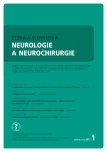Essential Neurological Examination – Time for Change?
Authors:
E. Růžička 1; P. Marusič 2
Authors‘ workplace:
Neurologická klinika a Centrum klinických neurověd 1. LF UK a VFN v Praze
1; Neurologická klinika 2. LF UK a FN Motol, Praha
2
Published in:
Cesk Slov Neurol N 2017; 80/113(1): 84-91
Category:
Short Communication
doi:
https://doi.org/10.14735/amcsnn201784
Overview
In neurology, diagnosis has traditionally been based on detailed history taking followed by a highly structured clinical exam. However, considering advances in auxiliary diagnostic methods, such a complex and time-consuming approach may seem superfluous. We thus aimed to determine the components of the codified neurological assessment used by Czech neurologists during a screening neurological exam and to compare results with surveys performed in Canadian and Brazilian neurologists. Four groups including a total of 101 Czech neurologists and residents participated in an anonymous survey. In a questionnaire consisting of 47 components of the routine neurological exam, respondents were asked to rate each item on a 4-point scale, indicating how important they considered it to be for screening a patient with nonspecific symptoms. The Delphi Method was used to determine consensus. Our neurologists concordantly rated 21 items as essential. The content of the screening neurological exam does not essentially differ between Czech neurologists and trainees from different neurological departments. Accordingly, there were few differences between the screening neurological exam as performed by the Czech and Canadian or Brazilian neurologists. Examination of visual fields and fundoscopy are usually not performed by Czech neurologists. On the contrary, articulation, tongue movements, heel-to-knee and Romberg test were selected by Czech but not Canadian or Brazilian neurologists. After adjustments taking into account both local and foreign experiences and current needs, we propose a 22-item neurological examination as an essential tool to exclude or confirm significant nervous system affection. Specific medical history or abnormal findings of the initial assessment should be followed by specific targeted examinations and tests leading to timely diagnosis and effective treatment.
Key words:
neurological examination – surveys and questionnaires
The authors declare they have no potential conflicts of interest concerning drugs, products, or services used in the study.
The Editorial Board declares that the manuscript met the ICMJE “uniform requirements” for biomedical papers.
Sources
1. Haškovec L. Všeobecná symptomatologie a diagnostika chorob nervových: pro studium a praktickou potřebu. Praha: Ladislav Haškovec 1931.
2. Vítek J. Obecná neurologie. Praha: Lékařské nakladatelství 1949.
3. Henner K. Speciální neurologie pro mediky a lékaře. Praha: Zdravotnické nakladatelství 1948.
4. Déjerine J. Sémiologie des affections du système nerveux. Paris: Masson 1914.
5. Roth J, Fiala O, Růžička E. Multimediální vzdělávací program pro výuku neurologie. Neurologické vyšetření. [přístup 2016 ČVN 20]. Dostupné z URL: https://el.lf1.cuni.cz/neurologie.
6. Zinchuk AV, Flanagan EP, Tubridy NJ, et al. Attitudes of US medical trainees towards neurology education: „Neurophobia“ – a global issue. BMC Med Educ 2010;10:49. doi: 10.1186/ 1472-6920-10-49.
7. Flanagan E, Walsh C, Tubridy N. „Neurophobia“ attitudes of medical students and doctors in Ireland to neurological teaching. Eur J Neurol 2007;14(10):1109– 12.
8. Nicholl DJ, Appleton JP. Clinical neurology: why this still matters in the 21st century. J Neurol Neurosurg Psychiatry 2015;86(2):229– 33. doi: 10.1136/ jnnp-2013-306881.
9. Moore FG, Chalk C. The essential neurologic examination: what should medical students be taught?Neurology 2009;72(23):2020– 3. doi: 10.1212/ WNL.0b013 e3181a92be6.
10. Gelb DJ, Gunderson CH, Henry KA, et al. The neurology clerkship core curriculum. Neurology 2002;58(6):849– 52.
11. de Villiers MR, de Villiers PJ, Kent AP. The Delphi technique in health sciences education research. Med Teach 2005;27(7):639–43.
12. Dirks M, Niessen LW, Koudstaal PJ, et al. Intravenous thrombolysis in acute ischaemic stroke: from trial exclusion criteria to clinical contraindications. An international Delphi study. J Neurol Neurosurg Psychiatry 2007;78(7):685– 9.
13. Lima MA, Maranhao-Filho P. What is the essential neurological examination? Arq Neuropsiquiatr 2012;70(12):939– 41.
14. Gigerenzer G, Gaissmaier W. Heuristic decision making. Annu Rev Psychol 2011;62:451– 82. doi: 10.1146/ annurev-psych-120709-145346.
15. Marewski JN, Gigerenzer G. Heuristic decision making in medicine. Dialogues Clin Neurosci 2012;14(1):77– 89.
16. Vickrey BG, Samuels MA, Ropper AH. How neurologists think: a cognitive psychology perspective on missed diagnoses. Ann Neurol 2010;67(4):425– 33. doi: 10.1002/ ana.21907.
17. Baker SK. Characterization of a novel C8 phasic muscle stretch reflex. Muscle Nerve 2009;40(4):529– 34. doi: 10.1002/ mus.21338.
18. Daum C, Aybek S. Validity of the „Drift without pronation“ sign in conversion disorder. BMC Neurol 2013;13:31. doi: 10.1186/ 1471-2377-13-31.
19. Thomas KE, Hasbun R, Jekel J, et al. The diagnostic accuracy of Kernig‘s sign, Brudzinski‘s sign, and nuchal rigidity in adults with suspected meningitis. Clin Infect Dis 2002;35(1):46– 52.
20. Ghosh D, Karunaratne P. The importance of good history taking: a case report. J Med Case Rep 2015;9:97. doi: 10.1186/ s13256-015-0559-y.
Labels
Paediatric neurology Neurosurgery NeurologyArticle was published in
Czech and Slovak Neurology and Neurosurgery

2017 Issue 1
Most read in this issue
- Current Perception of Contraindications and Complications of Nerve Conduction Studies and Needle Electromyography
- Essential Neurological Examination – Time for Change?
- Extirpation of Colloid Cyst by an Endoscopic Approach
- Periodic Limb Movements During Sleep are More Severe in Narcolepsy with Cataplexy than in Narcolepsy without Cataplexy
